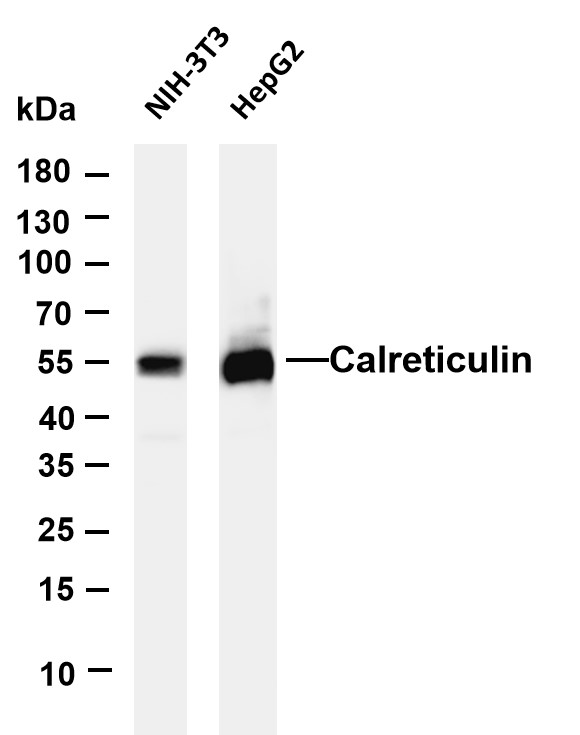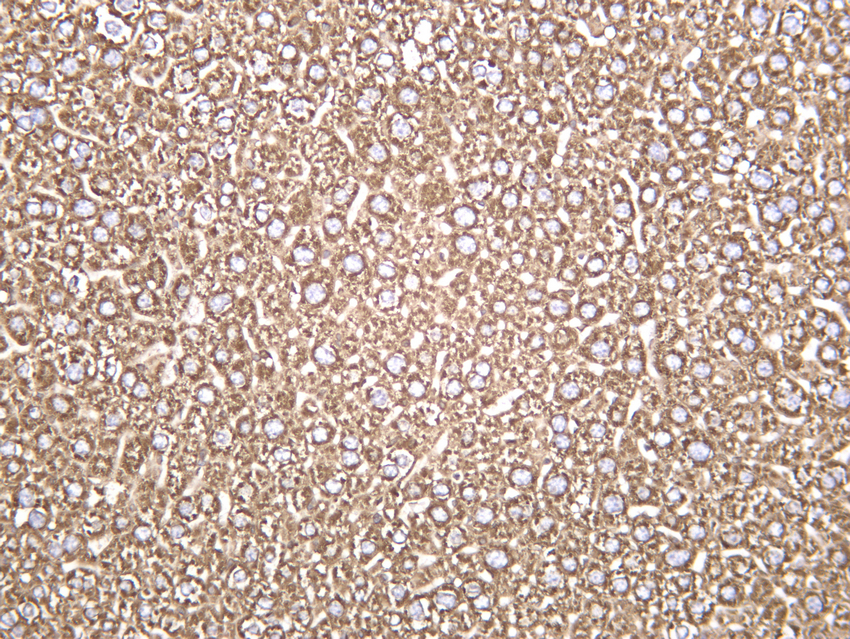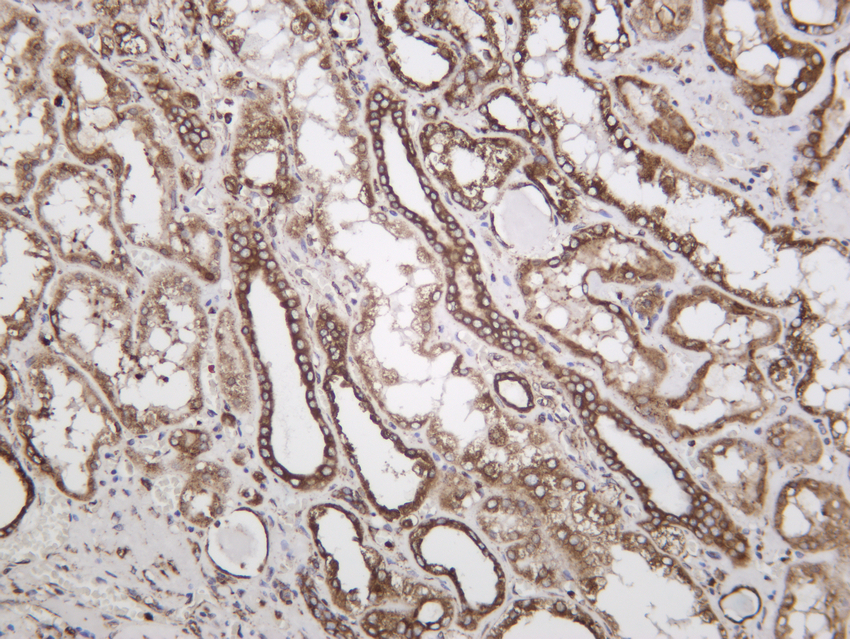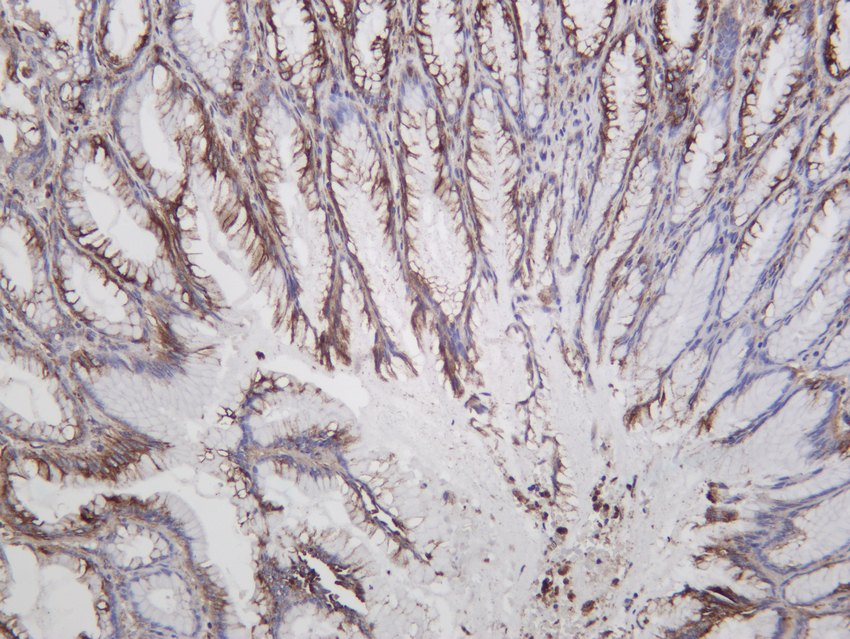Calreticulin (PT0256R) PT® Rabbit mAb
- Catalog No.:YM8162
- Applications:WB;IHC;IF;IP;ELISA
- Reactivity:Human;Mouse;Rat;
- Target:
- Calregulin
- Fields:
- >>Protein processing in endoplasmic reticulum;>>Phagosome;>>Antigen processing and presentation;>>Chagas disease;>>Human cytomegalovirus infection;>>Human T-cell leukemia virus 1 infection;>>Herpes simplex virus 1 infection;>>Epstein-Barr virus infection;>>Human immunodeficiency virus 1 infection
- Gene Name:
- CALR
- Protein Name:
- Calreticulin
- Human Gene Id:
- 811
- Human Swiss Prot No:
- P27797
- Mouse Gene Id:
- 12317
- Mouse Swiss Prot No:
- P14211
- Rat Gene Id:
- 64202
- Rat Swiss Prot No:
- P18418
- Specificity:
- endogenous
- Formulation:
- PBS, 50% glycerol, 0.05% Proclin 300, 0.05%BSA
- Source:
- Monoclonal, rabbit, IgG, Kappa
- Dilution:
- IHC 1:200-1:1000,WB 1:1000-1:5000,IF 1:200-1:1000,ELISA 1:5000-1:20000,IP 1:50-1:200,
- Purification:
- Protein A
- Storage Stability:
- -15°C to -25°C/1 year(Do not lower than -25°C)
- Other Name:
- CALR;CRTC;Calreticulin;CRP55;Calregulin;Endoplasmic reticulum resident protein 60;ERp60;HACBP;grp60
- Molecular Weight(Da):
- 48kD
- Observed Band(KD):
- 55kD
- Background:
- Calreticulin is a multifunctional protein that acts as a major Ca(2+)-binding (storage) protein in the lumen of the endoplasmic reticulum. It is also found in the nucleus, suggesting that it may have a role in transcription regulation. Calreticulin binds to the synthetic peptide KLGFFKR, which is almost identical to an amino acid sequence in the DNA-binding domain of the superfamily of nuclear receptors. Calreticulin binds to antibodies in certain sera of systemic lupus and Sjogren patients which contain anti-Ro/SSA antibodies, it is highly conserved among species, and it is located in the endoplasmic and sarcoplasmic reticulum where it may bind calcium. The amino terminus of calreticulin interacts with the DNA-binding domain of the glucocorticoid receptor and prevents the receptor from binding to its specific glucocorticoid response element. Calreticulin can inhibit the binding of androgen receptor to its
- Function:
- caution:Was originally (PubMed:2332496) thought to be the 52 kDa Ro autoantigen.,domain:Associates with PDIA3 through the tip of the extended arm formed by the P-domain.,domain:Can be divided into a N-terminal globular domain, a proline-rich P-domain forming an elongated arm-like structure and a C-terminal acidic domain. The P-domain binds one molecule of calcium with high affinity, whereas the acidic C-domain binds multiple calcium ions with low affinity.,domain:The interaction with glycans occurs through a binding site in the globular lectin domain.,domain:The zinc binding sites are localized to the N-domain.,function:Molecular calcium binding chaperone promoting folding, oligomeric assembly and quality control in the ER via the calreticulin/calnexin cycle. This lectin interacts transiently with almost all of the monoglucosylated glycoproteins that are synthesized in the ER. Interacts
- Subcellular Location:
- Cytoplasm
- Expression:
- Brain,Cajal-Retzius cell,Colon carcinoma,Eye,Fetal brain cortex,Keratinocyte,Liver,Pancreas
- June 19-2018
- WESTERN IMMUNOBLOTTING PROTOCOL
- June 19-2018
- IMMUNOHISTOCHEMISTRY-PARAFFIN PROTOCOL
- June 19-2018
- IMMUNOFLUORESCENCE PROTOCOL
- September 08-2020
- FLOW-CYTOMEYRT-PROTOCOL
- May 20-2022
- Cell-Based ELISA│解您多样本WB检测之困扰
- July 13-2018
- CELL-BASED-ELISA-PROTOCOL-FOR-ACETYL-PROTEIN
- July 13-2018
- CELL-BASED-ELISA-PROTOCOL-FOR-PHOSPHO-PROTEIN
- July 13-2018
- Antibody-FAQs
- Products Images

- Various whole cell lysates were separated by 4-20% SDS-PAGE, and the membrane was blotted with anti-Calreticulin (PT0256R) antibody. The HRP-conjugated Goat anti-Rabbit IgG(H + L) antibody was used to detect the antibody. Lane 1: NIH-3T3 Lane 2: HepG2 Predicted band size: 48kDa Observed band size: 55kDa

- Mouse liver was stained with Anti-Calreticulin (PT0256R) rabbit antibody

- Human kidney was stained with Anti-Calreticulin (PT0256R) rabbit antibody

- Human stomach was stained with Anti-Calreticulin (PT0256R) rabbit antibody



